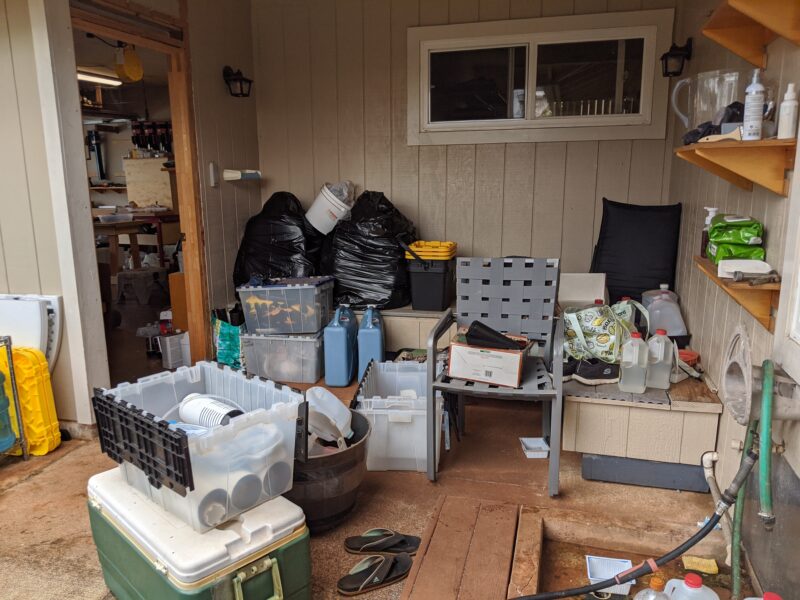This post may contain affiliate links, which means I'll earn a small commission if you purchase something through these links. You won't pay any extra; instead, you'll be helping Aloha With Love to thrive. Thank you! Learn more.
--
In Hawaii, hurricane season runs from June 1 – November 30. It’s that time of the year where our grocery stores will be overrun with customers buying bottled water. If you don’t know what I’m talking about, don’t worry, you soon will.
In general, most people know what they need in their house before a hurricane strikes: bottled water, non-perishable food, extra batteries, flashlights and/or candles, a way to cook your food, etc. You can buy all kinds of disaster kits online or locally, but our family just keeps everything stored in our house or garage.
But what happens when you need to get your house ready for a hurricane? Your house needs to be prepared against strong winds, heavy rains, big waves (if you live next to the beach), and flying branches. I have memories of my Dad going around the house getting our house ready for Hurricane Iniki, which hit Hawaii in 1992.
Hurricane Iniki was expected to be a big one and as an innocent 7 year old, it seemed like a grand adventure to me. Dad ran around the house putting things away while Mom filled up every single container she could find with water.
These days, my brother and I both help with getting everything strapped down and ready for the storm. We know the drill, so I thought this would be a great opportunity to share how we prepare our house for a hurricane.
Are you ready to lose your electricity?
Like any storm, expect to lose your electricity if things get bad. In Hawaii, we still have telephone poles and trees that can be blown away, so make sure you can survive at least 3 days without electricity.
- Charge all items to 100% in advance.
- Stock up batteries for your radio, lights, and other small appliances.
- Have a propane or butane stove on hand.
- Wash your clothes in advance.
- Cook extremely perishable foods such as raw meat.
- Have an extra large water source to wash yourself with.
- Store drinking water, enough to last you several days.
Typical power outages on Oahu usually don’t last more than a day or two (after the storm). But on the outer islands, it’s possible to have a power outage that lasts for several days, so be prepared.
My family will usually fill up one of our tubs with water so we can use it for flushing the toilet and sponge baths if we happen to lose electricity and/or the water stops running. In the past when we only had showers in our bathrooms, we filled up large coolers with water and left them outside. These are great since they won’t blow away and the drain plug means easy access.
Drinking water is also important. Most people in Hawaii will buy a case of bottled water for hurricane season. You’ll begin to see the signs at grocery stores saying “no returns for bottled water” – that’s how you know it’s hurricane season. The most popular choice is to head to Costco, which can get crowded with the procrastinators at the last minute. I recommend buying your case of bottled water in the beginning of hurricane season and holding on to it through November. When any of the hurricanes look like they will take a turn for the worst, there tends to be a huge rush at the stores for bottled water and it’s no surprise when they run out.
Tie loose items down and bring them into a sheltered corner
When a hurricane hits Hawaii, its winds are disastrous. Reaching speeds of over 100 mph, hurricane winds have the power to fell telephone poles, break trees, and make any loose items around your house fly.
That’s why it’s so important to gather all of your loose items together and tie, store, or secure them. We have several plastic bins that we use to hold small loose items such as tools, buckets, and empty gardening pots. This helps prevent a big mess to clean up after the hurricane and it also keeps your home and your neighbors’ homes safer.
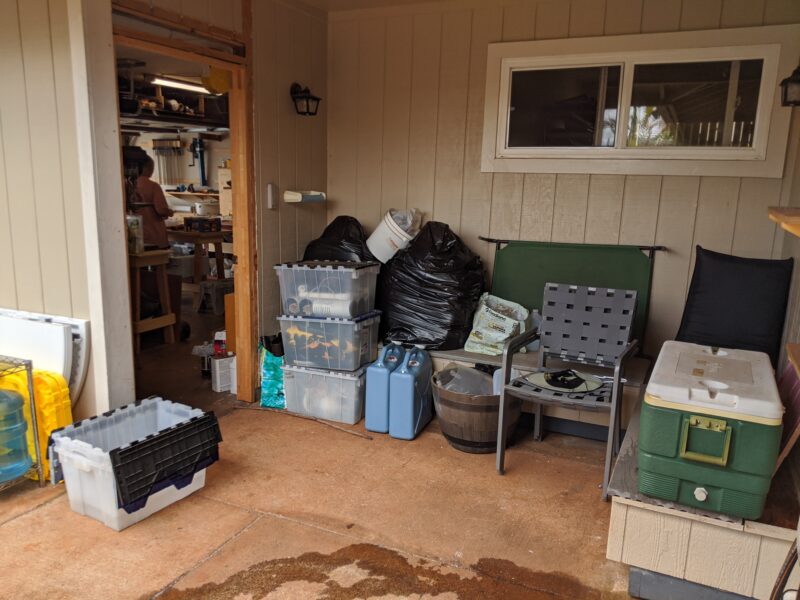

We’ll also move everything into a sheltered corner or into our garage. Even during high winds, as long as our house is standing, we won’t have to worry about strong winds blowing our smaller/lighter items away.
Make sure long items in particular are secured: planks of wood, pipes, and ladders could potentially fly off and severely damage someone’s house, window, or car.
How to get your yard and garden ready for hurricane winds
Mom is an expert at getting our yard and garden ready for a hurricane. We have a garden shed that already sits in a corner. We fit as many large garden tools inside as possible to make it heavy and impossible to topple over. For extra security, we’ve installed hooks to the house and use a ratchet strap to hold the doors closed.
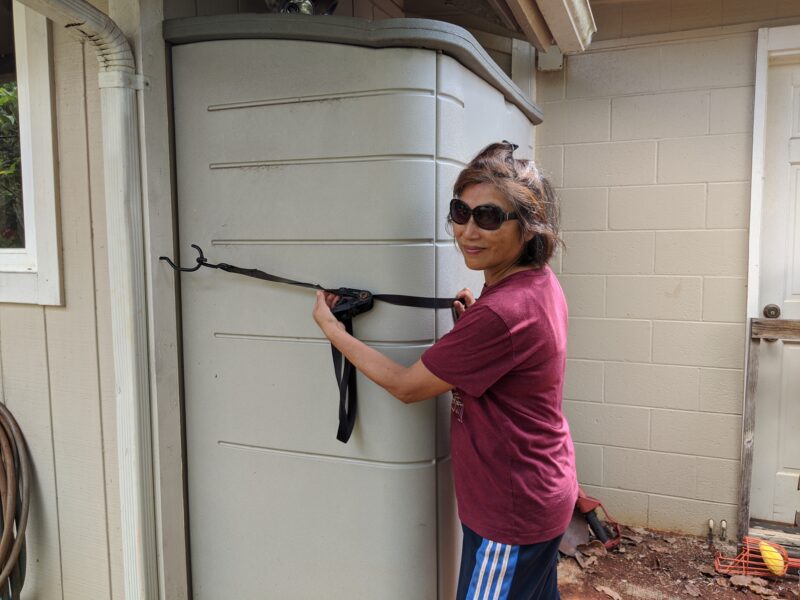
Mom constantly trims her dwarf Thai mango tree and saves the leaves to make mulch. Since we don’t want the leaves to fly around and make a mess for the entire neighborhood, we (aka my brother Michael) rake the leaves into one big pile and cover it with wide and heavy items to prevent them from flying off.

Another good idea is to pick all of your fruits and vegetables that are ripe or close to ripe. If the wind is going to blow them away, you might as well pick them before they’re completely unusable. Very green fruits and vegetables have a higher chance of staying attached.
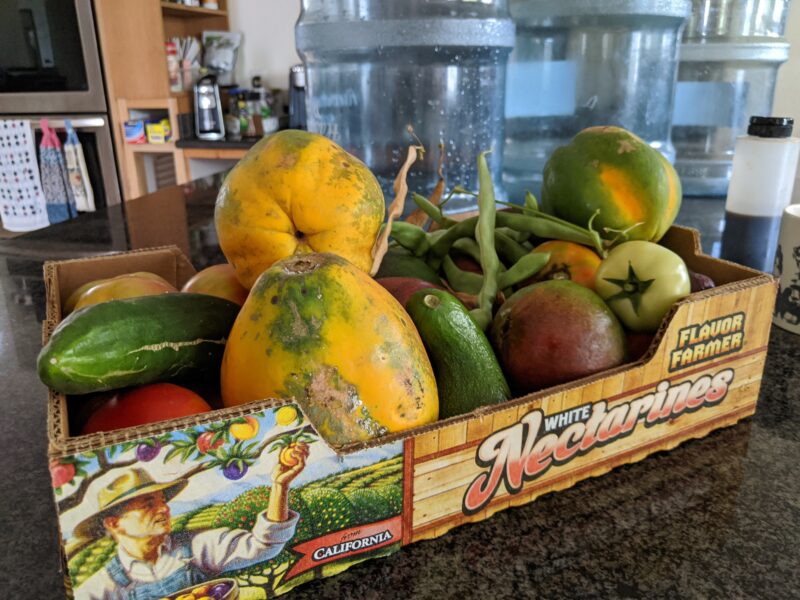
Drain the water away from your house
Most houses in Hawaii are built on a slope to encourage water to drain away from your house, out into the streets and eventually into the gutter. Weeds, dried leaves, and roots will stop free-flowing drainage and create a flood at the base of your house.
One problem section for us is the narrow walkway on the side of our house. We have a long and skinny length of dirt that attracts weeds. A couple of times a year we clean this area out to prevent flooding from regular storms, so we’ll do a check and pull out weeds and roots when a hurricane comes.
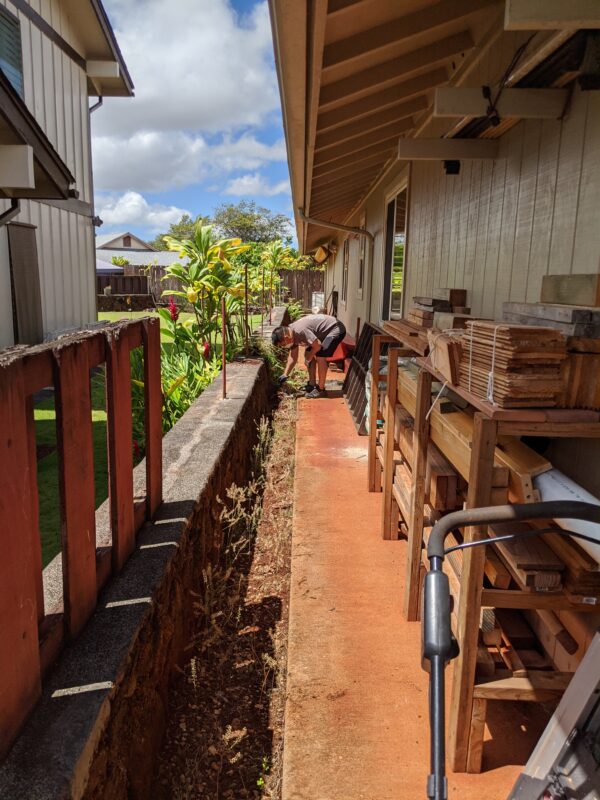
Clear your rain gutters (and check your roof for holes)
In addition to good drainage on the ground, you want your rain gutters to be clear of leaves, small branches, and other debris. These tend to collect in your rain gutter especially if you have tall trees near your house and if birds like to next in your roof.
Local Tip: Don’t let birds nest in your roof. Their poop weakens the wood and you may find yourself with a big hole in your house with the next hurricane.
Our method is to bring the hose up to the roof and shoot the debris out until the gutter drains freely. This needs to be done periodically, otherwise you’ll have water collecting on your roof, which is never good. Sitting water will create leaks and if it gets heavy enough, your roof can collapse.
What about your windows? Some of the older houses in Hawaii use jalousies, which can be extremely fragile during a hurricane. When I was small, Dad would board up our windows because our window jalousies were so old. Since then, we’ve had our house renovated and updated the windows to a heavy-duty window that can survive a hit from a flying object.
Recycle your cans, plastic, and glass bottles
It makes sense to secure your rubbish because the last thing anyone wants to do is clean up smelly and rotting food. Use straps, heavy items, and tight spaces to secure them. But what do you do with your cans, plastic, and glass bottles?
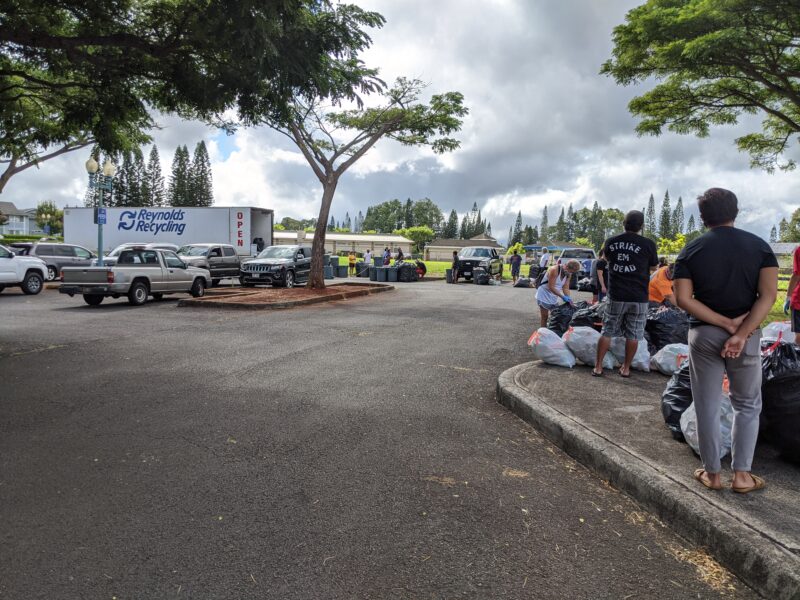
If you recycle your aluminum cans and plastic and glass bottles, you’re probably storing them in trash bags outside until you have several bags to make it worth your time driving to the recycling center. Since these will easily fly away and make a mess during a hurricane, make sure you take these to the recycling at least 2 days in advance.
Local Tip: I recommend taking your recyclables at least 3 days before the hurricane hits. I’ve gone both 2 days and 1 day before the hurricane hits – it is not fun. One time the container filled up early and I had to leave the cans in my car overnight. Another time I waited in line for at least 2 hours.
How do you know if a hurricane in Hawaii will be bad?
I used to work for a local tourism company and we would always get phone calls from visiting tourists worried about how the hurricane would affect their travel plans. In most cases, we know which hurricanes are forming and headed toward Hawaii within a week. At about 3 days, news sources and weather stations will have a good idea if Hawaii is in the storm’s path and they’ll be actively tracking it 24/7.
However, it isn’t until about 24 hours before that you’ll know if the hurricane will actually hit the islands or not and what strength they predict it will be at. Even then, predictions can sometimes not happen. I’ve seen hurricanes that were predicted to hit Hawaii veer off and leave us with sunny weather. But I’ve also seen other hurricanes that dropped to a tropical storm level then sit right on the islands and not move bringing massive rainfall and floods.
Whatever the case, take hurricanes seriously and prepare for them a few days in advance. Many of us who live here procrastinate getting ready (I’m one of them) and it’s not fun when you end up suffering for it.
Stay safe!
Aloha with love,
Amy

